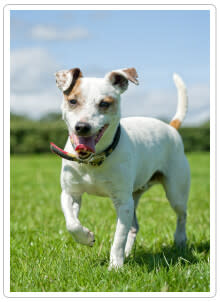
Who can resist a Hollywood canine, be it Lassie, Rin Tin Tin, or Fly (the adorable Border Collie in Babe)? For decades, an assortment of lovable terriers, retrievers, and similar turbo-charged breeds have charmed us on the big screen with their shenanigans. While those cinematic canine high jinks make us laugh and always end happily, living with a high-drive, high-energy dog is nothing like the movies! Okay... maybe a horror movie, because life can be a nightmare when your dog's triple A-type personality clashes with your personality, lifestyle, and doggie-know how.
If your high-octane dog is driving you crazy, don't despair. While living with these dogs can be challenging, it's not impossible and well within the capabilities of most owners. The key is understanding your dog's history and then managing his physical and mental needs in a positive and fun way.
Once you understand your breed’s history, origin, and the function for which he was originally bred, you'll have a better understanding of what traits your dog is likely to possess. By understanding why your terrier is obsessed with digging, or your herding dog chases and nips the heels of fleeing children, or your retriever is manic about water, you’ll be better equipped to channel his natural instincts and abundance of energy into productive behaviors - while simultaneously discouraging unwanted behaviors.
Of course, you'll need plenty of energy to keep up with your turbo-charged dog, and a sense of humor is important too. Living with a high-energy dog is a journey that is guaranteed to be simultaneously exasperating and exhilarating.
Why Your Dog Does What He Does
Long before dogs became pampered pets, early breeders—primarily farmers, ranchers, and hunters—selectively bred dogs based on working ability and physical and mental soundness, rather than the dog's physical appearance and uniformity, which are more modern-day requirements. The majority of today's retrievers, hounds, terriers, and herding dogs—those breeds that typically fall into the high-energy category, and now live as companion pets—descended from strong working ancestry. These dogs were bred for full-time jobs that required enormous amounts of energy, drive, stamina, courage, tenacity, and intelligence. The qualities that make them superior working dogs are the very qualities that often make them unsuitable as urban pets. For instance, Border Collies, which are wildly popular, have been bred for hundreds of years with one primarily goal in mind: improved herding ability. They are the working stiffs of the herding world, and they live it morning 'til night. Physically and mentally capable of doing their job and doing it all day long, it's easy to see why a 10-minute walk around the block is never going to satisfy their physical and mental requirements.
Give Your Dog a Job
Taking the sheepdog off the farm or the terrier out of a vermin hunting environment doesn't squelch a dog's drive, energy or desire to work. This is where problems arise and the human-canine relationship often runs amok. In the absence of physical and mental stimulation, these dogs can quickly become bored, which leads to unwanted behaviors such as shredding furniture, digging, excessive barking, ransacking trashcans, and so forth. Sound familiar?
It seems almost simplistic, but a key to successfully living with these dogs is giving them a job that is physically and mentally stimulating. It need not be the job that they were originally bred to do. After all, not every owner has access to sheep or lakes or vermin hunting. That said, plenty of canine sports are readily available—herding, obedience training, retrieving, field work, nose work, Schutzhund, agility, flyball, jogging, hiking, swimming, skijoring, dock diving—that will help to fill your dog's need for physical and mental exercise.
Trick training is an equally fun way to expand the human-canine relationship while mentally challenging your dog. Consider, for instance, starting with some relatively easy tricks, such as wave, walk back, spin or twist, and then progressing to more challenging tricks, such as jumping through a hoop, leg weaving, and touch training. Plenty of books and DVDs are available on how to teach tricks.
A tired dog is a good dog, and you'll be surprised at how many unwanted behaviors "disappear" when your dog is, well, “dog tired.”
Fall In Love with Your Dog
Fall in love with my dog? Why not? I'm the first to admit that dogs are not furry people. But if you've ever been deeply touched by a dog—you'll know what I'm saying. Make your dog a valued member of your family. Spend quality time with him. Develop an emotional bond. Invest in his physical and mental health. Spend time grooming him, snuggling with him, and whispering sweet nothings in his ear. Understand his body language—his ear twitches, cocked head, sympathetic eyes, and sense of humor. Yes, I believe dogs have those too! Let yourself be the first person he sees in the morning, and the last person he sees before nodding off to dream about all things dog.
We owe it to our dogs—especially high-drive, high-energy dogs—to invest time and energy in providing them with a relationship that is nothing short of fair, honest, and humane. Again, you'll be surprised at how easy—and fun—it is living with a high-drive, high-energy dog when you invest time and energy into building a strong and mutually respectful human-canine relationship.